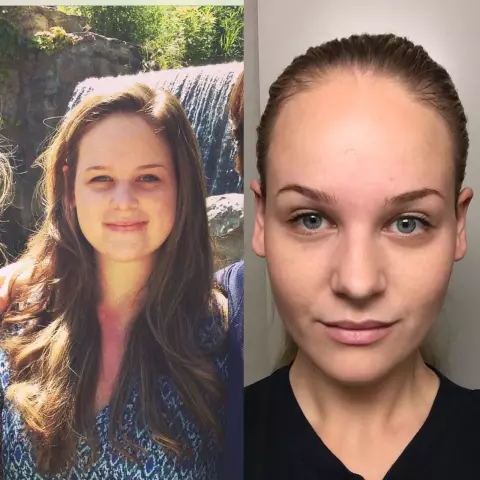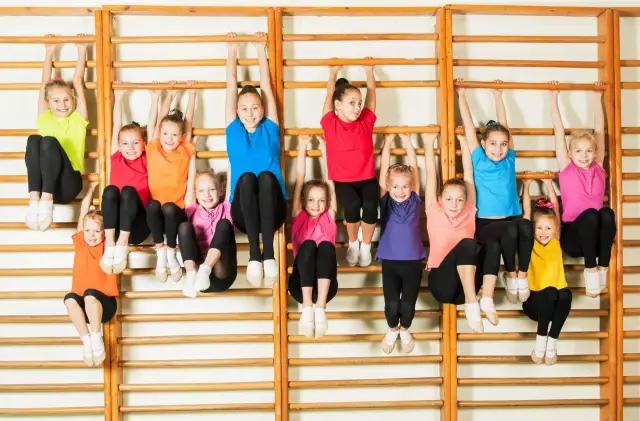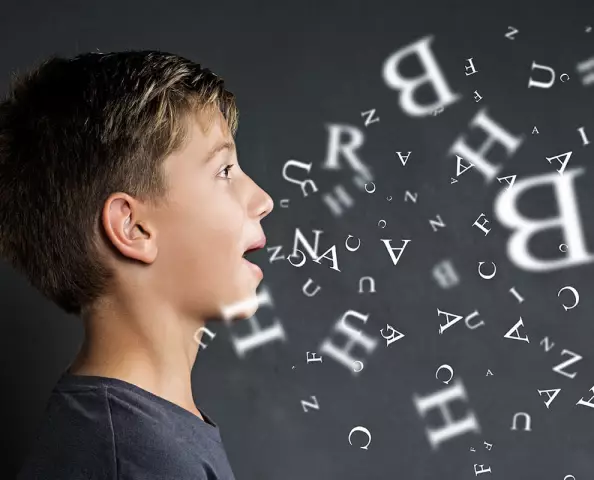- Author Rachel Wainwright [email protected].
- Public 2023-12-15 07:39.
- Last modified 2025-11-02 20:14.
Stuttering in children
The content of the article:
- Causes of stuttering in children and risk factors
- Forms of stuttering in children
- Stuttering stages in children
- Symptoms
- Diagnostics
- Treatment of stuttering in children
- Stuttering massage for children
- Exercises for stuttering in children
- Possible complications and consequences
- Forecast
- Prevention
Stuttering in children is a speech defect in which convulsive movements of the muscles of the articulatory, vocal and respiratory parts of the speech apparatus occur at the beginning or middle of speech, as a result of which the patient lingers on a certain sound or group of sounds. Stuttering is not an irreversible disorder of the central nervous system.
Most often, stuttering in children is first detected at the age of 2-5, ie, during the period of intensive formation of the child's speech function. Less often, the pathological process manifests itself in early school or adolescence. The most vulnerable period, that is, the one in which the risk of developing pathology is especially high, is the age of 2-4 and 5-7 years.
Stuttering is a fairly common pathology, it is observed in 5-8% of children, in boys almost 3 times more often than in girls. In addition, it is more stable in boys. Hereditary burden is found in about 17.5% of cases of neurotic stuttering in children.

Source: old.doctorneiro.ru
Causes of stuttering in children and risk factors
It is not always possible to identify the exact cause of stuttering in children.
Risk factors include:
- hereditary predisposition;
- congenital weakness of the speech apparatus;
- violation of the development of a sense of rhythm and motor skills, mimic-articulatory movements;
- organic pathologies of the central nervous system;
- intrauterine trauma or trauma received while passing through the birth canal;
- excessive mental stress;
- metabolic disorders.
Stuttering in children can be provoked by instantaneous mental trauma (severe fright, excitement, separation from loved ones), bilingualism or multilingualism in the family, pathologically accelerated speech rate (tachyllalia), fuzzy pronunciation of words, excessive demands on the child's speech, imitation (with prolonged communication with stuttering people). Pathology can form against the background of prolonged mental neurotization with a prolonged unfair and rude attitude towards the child (punishment, threats, constant elevated tone), a bad psychological climate in the family, enuresis, increased irritability, night fears.
Stuttering in children can manifest itself after a severe infectious disease, as well as its complications.
Forms of stuttering in children
According to the etiological factor, stuttering in children is divided into two forms:
- neurotic (logoneurosis) - due to psychological trauma, can develop at any age;
- neurosis-like - due to dysfunctions of cerebral structures, usually occurs in 3-4 years.
Depending on the characteristics of speech impairment, stuttering can be of the following types:
- tonic - delay on a sound or a group of sounds;
- clonic - repetition of sounds, syllables or words;
- mixed.
Stuttering stages in children
There are four stages in the development of pathology:
- Pronunciation disorders often occur in the initial words of sentences, when pronouncing short parts of speech (conjunctions, prepositions), the child does not respond to his difficulties in pronouncing words.
- Speech disorders occur regularly, more often during fast speech, in polysyllabic words, the child notes difficulties with speech, but does not consider himself a stutter.
- The consolidation of the convulsive syndrome is noted, the patients do not experience awkwardness or fear when communicating.
- Expressed emotional reactions to stuttering, the child tries to avoid communication.
Symptoms
Often, stuttering is accompanied by somatic disorders of the articulatory apparatus: deviation of the tongue to the side, high fornix of the palate, hypertrophy of the nasal cavity shells, curved nasal septum.
Respiratory disorders include excessive consumption of air during inhalation and exhalation against the background of a disorder of resistance in the area of articulation. When trying to pronounce sounds, a convulsive closure of the glottis occurs, which prevents the formation of sound. In this case, there are fast and sharp movements of the larynx up and down, as well as forward movement. Patients attempt to pronounce vowel sounds firmly. At the same time, the symptoms of stuttering can be mitigated up to the complete normalization of speech when singing, whispering.
The patient can accompany his speech with accompanying gestures that are not necessary, but are made by the child consciously. During an attack of stuttering, a child can tilt his head or throw it back, clench his fist, stomp his foot, shrug his shoulders, shift from foot to foot.
Sometimes stuttering is accompanied by mental disorders, for example, the fear of failing in the pronunciation of certain sounds, syllables and words. Patients try not to use them in their speech and look for a replacement for them. In severe cases, this leads to absolute dumbness during attacks of stuttering. Thoughts about the impossibility of normal verbal communication can become the reason for the formation of an inferiority complex. Children become shy, fearful, silent, and can shy away from conversation and communication in general.
In the tonic form of stuttering, the child often stumbles during a conversation with the formation of pauses or excessive stretching of individual syllables in the word. In the clonic form of pathology, the patient pronounces individual sounds, groups of sounds or words several times. The mixed form of stuttering is characterized by a combination of signs of tonic and clonic stuttering. In the clonic-tonic form of stuttering, the patient usually repeats the initial sounds or syllables, after which he stumbles during a conversation. With tonic-clonic stuttering, speech impairment manifests itself in the form of stutters and stops with a frequent increase in voice, pronounced breathing disorders and additional movements during a conversation.
If the patient develops neurotic stuttering, pronounced pronunciation disorders (slurred speech) are noted. Children with this form of pathology, as a rule, begin to speak later than their peers. With the development of a neurosis-like form of pathology, stuttering attacks usually occur in certain situations, for example, with excitement.
Sometimes stuttering in children is absent when talking with animals or inanimate objects, reading aloud.

Source: infourok.ru
Diagnostics
The diagnosis is made by a speech therapist or neurologist; a psychologist may be involved to clarify the form of stuttering.
Diagnostics is based on data obtained during the collection of complaints and anamnesis. The psychoemotional situation in the child's family, the situations in which stuttering occurs and / or aggravates, the circumstances under which the pathology manifested itself, the duration of the stuttering history are clarified.
Attention is focused on the presence of the following signs for three months or longer:
- difficulties and stutters at the beginning of speech;
- violation of the rhythm of speech (stretching of certain sounds, repetition of word syllables, scraps of words and / or phrases);
- attempts to cope with stuttering through side movements.
In order to exclude organic disorders of the nervous system, magnetic resonance imaging of the brain, electroencephalography, rheoencephalography may be required. Differential diagnosis is performed with blurred speech and spastic dysphonia.
Treatment of stuttering in children
Stuttering correction in children is aimed at developing correct speech skills, eliminating incorrect pronunciation, and overcoming psychological problems. A speech therapist, a neurologist and a psychotherapist take part in the treatment.

Source: ostrov-j.ru
With a neurotic form of stuttering, the success of treatment largely depends on the timely diagnosis of the pathological condition. Neurotic stuttering in young children lends itself well to correction in speech therapy groups and kindergartens. The main areas of stuttering treatment in specialized institutions are speech therapy rhythm and collective psychotherapy in a playful way. Family psychotherapy using relaxation, distraction, and suggestion is also important. Children are taught to speak in a chant or in time with the rhythmic movements of the fingers.
Medical treatment of neurotic stuttering consists in the appointment of general tonic and sedatives, antispasmodics, vitamin complexes. For this purpose, phytotherapy (motherwort, valerian, aloe) can be used.
Drug therapy for a neurosis-like form of stuttering caused by organic brain damage usually consists of the use of antispasmodic drugs, minimal doses of tranquilizers. In some cases, dehydration courses are shown.
Working with a psychotherapist is aimed at eliminating possible interpersonal conflicts, minimizing psychological factors that aggravate stuttering.
Treatment of stuttering in children in some cases includes physiotherapeutic methods: electrophoresis with sedatives on the collar zone, franklinization, electrosleep, etc.
Quiet atmosphere in the family, maintaining a rational daily routine (night sleep at least 8 hours a day), correct speech regime are important, often decisive for the successful treatment of stuttering in children. Children with stuttering are encouraged to practice dancing, singing, and music - this contributes to the formation of correct speech breathing, as well as a sense of rhythm and tempo.
The criterion for recovery is the child's normal speech in any situation, including in the case of high emotional stress (for example, speaking in front of an audience).
Stuttering massage for children
Massage for stuttering in children is carried out by a speech therapist during correction classes. In addition to the head and neck, massage extends to the shoulders, upper back and chest. Segmental and acupressure massage is widely used, as well as their combination.
Segmental massage is aimed at a separate effect on a specific muscle that regulates speech activity. This type of massage is performed daily for 2-3 weeks.
Acupressure massage is considered one of the most effective methods for correcting stuttering in children. It has a positive effect on the speech center, helps to remove its excessive excitability. Acupressure massage can be performed at home after preliminary training of parents by a specialist. Acupressure massage for stuttering in children is carried out regularly for two to three years.
Exercises for stuttering in children
The set of exercises includes breathing exercises, stretching to normalize muscle contractions, and eye exercises to improve perception.
The main goals of respiratory gymnastics for stuttering in children are mastering the technique of diaphragmatic breathing, conscious regulation of the respiratory rhythm, strengthening the muscles of the anterior abdominal wall. Respiratory gymnastics for stuttering in children consists in performing a set of exercises in various body positions, at rest and during active movement. Over time, verbal manifestations are connected to breathing exercises. A smooth increase in the level of complexity of exercises contributes to the speedy correction of pathology.
The most effective treatment for stuttering is observed when a combination of exercises with massage.
Possible complications and consequences
Stuttering in children can cause a narrowing of the child's circle of friends, the emergence of suspiciousness, anxiety, irritability, feelings of inadequacy, decline in school performance, problems with adaptation in society.
With incorrect or irregular correction, as well as in its absence, stuttering can persist for a long time, sometimes throughout life.
Forecast
Provided timely adequate treatment, the prognosis is favorable for 70-80% of patients.
Prevention
In order to prevent stuttering in children, it is recommended:
- maintaining a favorable psychological climate in the family, caring, attentive and benevolent attitude towards the child, refusal to be overly exacting;
- broadening the horizons of the child;
- avoidance of excessive mental stress;
- rational daily routine, good rest;
- correct teaching of the child to speak;
- balanced diet;
- preventive examinations by specialists, timely treatment of somatic pathology.
YouTube video related to the article:

Anna Aksenova Medical journalist About the author
Education: 2004-2007 "First Kiev Medical College" specialty "Laboratory Diagnostics".
The information is generalized and provided for informational purposes only. At the first sign of illness, see your doctor. Self-medication is hazardous to health!






